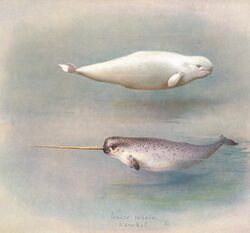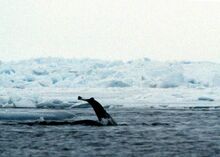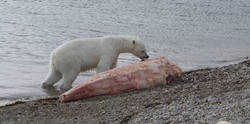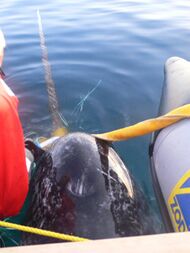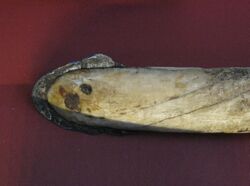Biology:Narwhal
| Narwhal[1] | |
|---|---|
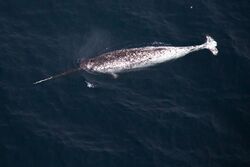
| |

| |
| Size compared to an average human | |
| Scientific classification | |
| Domain: | Eukaryota |
| Kingdom: | Animalia |
| Phylum: | Chordata |
| Class: | Mammalia |
| Order: | Artiodactyla |
| Infraorder: | Cetacea |
| Family: | Monodontidae |
| Genus: | Monodon Linnaeus, 1758 |
| Species: | M. monoceros
|
| Binomial name | |
| Monodon monoceros | |
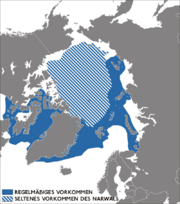
| |
| The frequent (solid) and rare (striped) occurrence of narwhal populations | |
The narwhal (Monodon monoceros), also known as the narwhale, is a species of toothed whale. It is a member of the Monodontidae family, and the only species in the genus Monodon. Adults are typically 3.95 to 5.5 m (13.0 to 18.0 ft) in length and 800 to 1,600 kg (1,800 to 3,500 lb) in weight. The most prominent feature of the species is an adult male's long single tusk that can be up to 3 m (9.8 ft). Instead of having a dorsal fin, narwhals possess a shallow dorsal ridge. They are gregarious animals, and may associate in groups of up to 20 members. Carl Linnaeus scientifically described the species in 1758 in his work Systema Naturae.
They are mostly found in Arctic waters, and are only vulnerable to predatory attacks from polar bears and orcas. Narwhals typically visit the Baffin Bay, between June and September. After this period, they move to Davis Strait, a journey that spans around 1,700 km (1,100 mi), and they stay there until April. Their prey mostly consists of Greenland halibut, polar and Arctic cod, cuttlefish, shrimp, and armhook squid. Narwhals are one of the deepest diving marine mammals, with many individuals diving at depths of over 1,500 m (4,900 ft). Adults mate in the offshore pack ice in April or May, and their gestation lasts for an average of 14 months. Like most other cetaceans, narwhals use clicks, whistles and knocks to communicate with each other.
There are estimated to be 170,000 living narwhals in the world, and the species is listed as least concern under the International Union for Conservation of Nature. Narwhals have been harvested for hundreds of years by Inuit in northern Canada and Greenland for meat and ivory and a regulated subsistence hunt continues. Narwhals have been depicted in human culture since ancient times.
Taxonomy
The narwhal was one of many species originally described by Carl Linnaeus in his 1758 Systema Naturae.[6] Its name is derived from the Old Norse word nár, meaning "corpse", in reference to the animal's greyish, mottled pigmentation,[7] and its summertime habit of lying still at or near the surface of the sea (called "logging").[8] The scientific name, Monodon monoceros, is derived from Greek: "one-tooth one-horn".[7]
The narwhal is most closely related to the beluga whale (Delphinapterus leucas). Together, these two species comprise the only extant members of the family Monodontidae, sometimes referred to as the "white whales". The Monodontidae are distinguished by their pronounced melons (acoustic sensory organ), short snouts and the absence of a true dorsal fin.[9]
Although the narwhal and the beluga are classified as separate genera, there is some evidence that they may, very rarely, interbreed. The remains of an abnormal-looking whale was discovered in West Greenland around 1990. It was described by marine zoologists as unlike any known species, and it had features midway between a narwhal and a beluga, indicating that the remains belonged to a narluga;[10] in 2019, this was confirmed by DNA and carbon/nitrogen isotopic analysis.[11]
Evolution
| |||||||||||||||||||||||||||||||||||||||||||||||||||||||||
| A phylogenetic tree of Monodontidae family.[12] |
The members of Delphinoidea—the white whales, dolphins and porpoises—are thought to share the same monophyletic origin. Genetic evidence suggests the porpoises are more closely related to the white whales and that these two families constitute a separate clade which diverged from the rest of Delphinoidea within the past 11 million years.[13] Fossil evidence shows that ancient white whales lived in tropical waters. They may have migrated to Arctic and sub-Arctic waters in response to changes in the marine food chain during the Pliocene.[14] A 2020 phylogenetic study based on genome sequencing suggested that, around 4.98 million years ago (mya), narwhals split from beluga whales.[15] Analysis of Monodontidae fossils indicates that they had separated from Phocoenidae around 10.82 to 20.12 mya; they are considered to be a sister taxon.[16]
Description
Narwhals are medium-sized whales and are around the same size as beluga whales. The body length, excluding the tusk, can range from 3.95 to 5.5 m (13 to 18 ft).[17] Males average 4.1 m (13.5 ft) in length; females average 3.5 m (11.5 ft). Adults range in weight from 800 to 1,600 kg (1,760 to 3,530 lb), with males outweighing their female counterparts.[17] Male narwhals attain sexual maturity at 11 to 13 years of age, when they are typically 3.9 m (12.8 ft) long. Females become sexually mature at a younger age, between 5 and 8 years old, when they are about 3.4 m (11.2 ft) long.[17]
The pigmentation of narwhals is a mottled pattern, with blackish-brown markings over a white background. They are darkest when born and become whiter with age; white patches develop on the navel and genital slit at sexual maturity. Old males may be almost pure white.[7][17][18] Narwhals do not have a dorsal fin; they instead possess a shallow dorsal ridge. This is possibly an evolutionary adaptation to make swimming under ice easier, to facilitate rolling, or to reduce surface area and heat loss.[19] Their neck vertebrae are jointed, like those of land mammals, instead of being fused together as in most whales, allowing a great range of neck flexibility. These characteristics are shared by the closely related beluga whale.[8] The tail flukes of female narwhals have a sweep-back in the front edges and those of males lack such a characteristic; their tail flukes are curved inwards. This is thought to be an adaptation for reducing drag caused by the tusk.[20]
Tusk
The most conspicuous characteristic of the male narwhal is a single long tusk, which is in fact a canine tooth[21][22] that projects from the left side of the upper jaw, through the lip and forms a left-handed helical spiral.[23] The tusk grows throughout the animal's life, reaching an average of 1.5 to 2.5 m (4.9 to 8.2 ft).[24][25] The maximum tusk length is 3 m (9.8 ft).[26] It is hollow and weighs 10 kg (22 lb). Some males may grow two tusks, occurring when the right canine also grows out through the lip.[27] Females rarely grow tusks: when they do, the tusks are typically smaller than those of males, with less noticeable spirals.[28][29]
The purpose of the narwhal tusk is a topic of constant debate. Some biologists suggest that narwhals use their tusks in fights, while others argue that their tusks may be of use in breaking sea ice or in finding food. However, there is a consensus that narwhals use their tusks for the role of secondary sexual characteristics, and may also use them for status.[30] The tusk is a highly innervated sensory organ with millions of nerve endings connecting seawater stimuli in the external ocean environment with the brain.[31][32][33][34] In a 2014 paper, it was suggested that the rubbing of tusks together by male narwhals is thought to be a method of communicating information about characteristics of the water each has travelled through, rather than the previously assumed posturing display of aggressive male-to-male rivalry.[21] In August 2016, drone videos of narwhals surface-feeding in Tremblay Sound, Nunavut, showed that the tusk was used to tap and stun small Arctic cod, making them easier to catch for feeding.[35][36] The tusk cannot serve a critical function for the animal's survival, as females—which generally do not have tusks—typically live longer than males. Therefore, the general scientific consensus is that the narwhal tusk is mainly used for breeding purposes.[37]
Vestigial teeth
The tusks are surrounded posteriorly, ventrally and laterally by several small vestigial teeth which vary in shape and material.[21] These teeth can sometimes be extruded from the bone, but mainly reside in open tooth sockets which are situated within the muzzle.[21][38] The varied morphology and anatomy of small teeth indicate a path of evolutionary obsolescence,[21] leaving the narwhal's mouth toothless.[38]
Genome
A 2.3 Gbp genome sequence has been assembled from multiple Illumina libraries. The genome was made of 37.9% repetitive elements and encodes 21,785 protein-coding genes. The genome assists in understanding the evolution and embryonic development of features such as the tusk and its sexual dimorphism.[39]
Behaviour and ecology
Narwhals normally congregate in groups of five to ten—and sometimes up to twenty—individuals. Groups may be "nurseries" with only females and young, or can contain only post-dispersal juveniles or adult males ("bulls"), but mixed groups can occur at any time of year.[17] In the summer, several groups come together, forming larger aggregations which can contain from 500 to over 1,000 individuals.[17] Bull narwhals have been observed rubbing each other's tusks, a display similar to "tusking".[32][40]
When in their wintering waters, narwhals make some of the deepest dives recorded for a marine mammal, diving to at least 800 m (2,620 ft) over 15 times per day, with many dives reaching 1,500 m (4,920 ft). Dives to these depths last around 25 minutes.[41] Dive times can also vary in time and depth, based on local variation between environments, as well as seasonality. For example, in the Baffin Bay wintering grounds, they tend to dive deep within the precipitous coasts, typically south of Baffin Bay. This suggests differences in habitat structure, prey availability, or genetic adaptations between subpopulations. In the northern wintering grounds, narwhals do not dive as deep as the southern population, in spite of the fact that water depths in these areas are typically deeper. This is usually a result of their prey moving in a vertical manner, which then causes narwhals to subsequently alter their foraging strategies.[41]
Diet
Compared to other marine mammals, narwhals have a relatively restricted and specialized diet.[42] Their prey is predominantly composed of Greenland halibut, polar and Arctic cod, cuttlefish, shrimp and armhook squid. Additional items found in stomachs have included wolffish, capelin, skate eggs and sometimes rocks.[17][43][44][40] In winter, they feed on demersal prey, mostly flatfish, under dense pack ice. During the summer, narwhals eat mostly Arctic cod and Greenland halibut, with other fish such as polar cod making up the remainder of their diet.[45] Due to the lack of well-developed dentition, narwhals are believed to feed by swimming close to prey and then sucking it into the mouth.[46] The distinctive tusk is used to tap and stun small prey, facilitating a catch.[35][36]
Narwhals have a very intense summer feeding spree. A team led by K.J. Finley tested 73 narwhals of different ages and genders to see what they ate. The individuals were from the Pond Inlet and had their stomach contents tested from June 1978 until September 1979. The study found in 1978 that the Arctic cod (Boreogadus saida) made up about 51% of the diet of the narwhals, with the next most common animal being the Greenland halibut (Reinhardtius hippoglossoides), consisting of 37%. A year later, the percentages of both animals in the diet of narwhals had changed, with Arctic cods representing 29% in 1979. The main prey of males were redfish (Sebastes marinus) and polar cod (Arctogadus glacialis); both species are predominantly found in depths deeper than 500 m (1,640 ft). The study found that the dietary needs of the narwhal did not differ among genders or ages.[47]
Breeding
Females start bearing calves when six to eight years old.[8] Adult narwhals mate from March to May when they are in the offshore pack ice. After a gestation of 15 months, females give birth to calves between July and August.[48] As with most marine mammals, only a single young is born, averaging 1.5 m (4.9 ft) in length and white or light grey in colour.[49] The birth interval is typically between two and three years.[50] During summer population counts along different coastal inlets of Baffin Island, calf numbers varied from 0.05% to 5% of the total numbering from 10,000 to 35,000 narwhals, indicating that higher calf counts may reflect calving and nursery habitats in favourable inlets.[51]
Newborn calves begin their lives with a thin layer of blubber which thickens as they nurse their mother's milk which is rich in fat. Calves are dependent on milk for around 20 months.[8] This long lactation period gives the calves time to learn skills they will need to survive as they mature. Calves typically stay within two body lengths of the mother.[8][51] The species is thought to go through menopause; during this phase, females may continue to take care of calves in the pod.[50]
Hybrids have been documented between the narwhal and beluga (specifically a beluga male and a narwhal female), with as many as three being killed and harvested during a sustenance hunt. Whether or not these hybrids could breed remains unknown. The unusual dentition seen in the only available skull indicates the hybrid hunted on the seabed, much as walruses do. This hunting technique is different from those of either parent species.[52][53]
Communication
Like most toothed whales, narwhals use sound to navigate and hunt for food. Narwhals primarily vocalise through "clicks", "whistles" and "knocks", created by air movement between chambers near the blow-hole.[54] The frequency of these sounds ranges from 0.3 to 125 hertz, while those used for echolocation typically falls between 19 and 48 hertz.[55][56] The sounds are reflected off the sloping front of the skull and focused by the animal's melon, which can be controlled through surrounding musculature. Echolocation clicks are primarily produced for prey detection and for locating obstacles at short distances. It is possible that individual "bangs" are capable of disorienting or incapacitating prey, making them easier to hunt, but this has not been verified.[54] "Whistles" and "throbs" are mostly used to communicate with other pod members.[54] Calls recorded from the same pod are more similar than calls from different pods, suggesting the possibility of group- or individual-specific calls in narwhals. Narwhals sometimes adjust the duration and pitch of their pulsed calls to maximise sound propagation in varying acoustic environments.[57] Other sounds produced by narwhals include trumpeting and "squeaking-door sounds".[8] The narwhal vocal repertoire is similar to that of the closely related beluga, with comparable whistle frequency ranges, whistle duration and repetition rates of pulse calls, however beluga whistles are thought to have a higher frequency range and more diversified whistle contours.[54]
Lifespan and mortality
Narwhals live an average of 50 years, however, age determination techniques using aspartic acid racemization from the lens of the eyes suggests that female narwhals can live to be as old as 115 ± 10 years and male narwhals for 84 ± 9 years.[58] Death by suffocation often occurs when narwhals fail to migrate before the Arctic freeze over in late autumn.[17][59] As narwhals breathe air, they drown if open water is no longer accessible and the ice is too thick for them to break through. Breathing holes in the ice may be up to 1,450 m (4,760 ft) apart, which limits the use of foraging grounds and these holes must be at least 0.5 m (1.6 ft) wide to allow an adult whale to breathe.[60] The last major entrapment events occurred when there was little to no wind. Entrapment can affect as many as 600 individuals, most occurring in narwhal wintering areas such as Disko Bay. In the largest entrapment in 1915 in West Greenland, over 1,000 narwhals were trapped under the ice.[61]
Despite the decreases in sea ice cover, there were several large cases of sea ice entrapment in 2008–2010 in the winter close to known summering grounds, two of which were locations where there had been no previous cases documented.[59] This suggests later departure dates from summering grounds. Sites surrounding Greenland experience advection (moving) of sea ice from surrounding regions by wind and currents, increasing the variability of sea ice concentration. Due to strong site fidelity, changes in weather and ice conditions are not always associated with narwhal movement toward open water. It is currently unclear how far sea ice changes pose a danger to narwhals. Narwhals also die of starvation.[17]
Major predators are polar bears, which typically wait at breathing holes for young narwhals, and Greenland sharks.[17][62] Orcas group together to overwhelm and surround narwhal pods,[63] in one case killing dozens of narwhals in a single attack.[64] To escape predators such as orcas, narwhals may use prolonged submergence to hide under ice floes rather than relying on speed.[60]
Humans hunt narwhals; narwhal products traded commercially include the skin, carved vertebrae, teeth and tusk, and the meat. About 1,000 narwhals are killed per year: 600 in Canada and 400 in Greenland. Canadian harvests were steady at this level in the 1970s, dropped to 300–400 per year in the late 1980s and 1990s and have risen again since 1999. Greenland harvested more, 700–900 per year, in the 1980s and 1990s.[65]
Tusks are sold with or without being carved in Canada[66][67] and Greenland.[68] An average of one or two vertebrae and one or two teeth per narwhal are carved and sold.[66] In Greenland the skin (muktuk) is sold commercially to fish factories,[68] and in Canada to other communities.[66] One estimate of the annual gross value received from narwhal hunts in Hudson Bay in 2013 was CA$530,000 for 81 narwhals, or CA$6,500 per narwhal. However the net income, after subtracting costs in time and equipment, was a loss of CA$7 per person. Hunts receive subsidies, but they continue mainly to support tradition, rather than for the money and the economic analysis noted that whale watching may be an alternate source of revenue. Of the gross income, CA$370,000 was for skin and meat; to replace beef, pork and chicken which would otherwise be imported, CA$150,000 was received for tusks and carved vertebrae and teeth of males and CA$10,000 was received for carved vertebrae and teeth of females.[66]
Distribution
The narwhal is found predominantly in the Atlantic and Russian areas of the Arctic Ocean. Individuals are commonly recorded in the Canadian Arctic Archipelago,[69][70] such as in the northern part of Hudson Bay, Hudson Strait, Baffin Bay; off the east coast of Greenland; and in a strip running east from the northern end of Greenland round to eastern Russia (170° East). Land in this strip includes Svalbard, Franz Joseph Land and Severnaya Zemlya.[7] The northernmost sightings of narwhals have occurred north of Franz Joseph Land, at about 85° North latitude.[7] Narwhals typically visit the Baffin Bay, between June and September. After this period, they move to Davis Strait, a journey that spans around 1,700 kilometres (1,100 mi), and they stay there until April. There are an estimated 12,500 narwhals in northern Hudson Bay, whereas around 140,000 whales reside in the Baffin Bay.[71]
Migration
Narwhals exhibit seasonal migrations, with a high fidelity of return to preferred, ice-free summering grounds, usually in shallow waters. In summer months, they move closer to coasts, often in pods of 10–100. In the winter, they move to offshore, deeper waters under thick pack ice, surfacing in narrow fissures in the sea ice, or leads.[44] As spring comes, these leads open up into channels and the narwhals return to the coastal bays.[72] Narwhals from Canada and West Greenland winter regularly in the pack ice of Davis Strait and Baffin Bay along the continental slope with less than 5% open water and high densities of Greenland halibut.[43] Feeding in the winter accounts for a much larger portion of narwhal energy intake than in the summer.[43][44]
Conservation
The narwhal is listed as least concern on the IUCN Red List. As of 2017, the global population is estimated to be 123,000 mature individuals out of a total of 170,000. There are around 12,000 whales in Northern Hudson Bay, as of 2011, and around 49,000 in Somerset Island in 2013. There are approximately a total of 35,000 in Admiralty Inlet, 10,000 in Eclipse Sound, 17,000 in Eastern Baffin Bay, and 12,000 in Jones Sound. Population numbers in Smith Sound, Inglefield Bredning and Melville Bay are 16,000, 8,000 and 3,000, respectively. There are possibly 837 narwhals off the waters of Svalbard.[4] Narwhals are listed on Appendix II of CITES and CMS.[5][73]
The United States has forbidden imports since 1972 under the Marine Mammal Protection Act.[74] The species is also classified as endangered under COSEWIC.[71] Narwhals are difficult to keep in captivity.[32]
Threats
Inuit are able to hunt this whale species legally. Narwhals have been extensively hunted the same way as other sea mammals, such as seals and whales, for their large quantities of fat. Almost all parts of the narwhal; the meat, skin, blubber and organs are consumed. Muktuk, the name for raw skin and attached blubber, is considered a delicacy. One or two vertebrae per animal are used for tools and art.[66][7] The skin is an important source of vitamin C which is otherwise difficult to obtain in the Arctic Circle. In some places in Greenland, such as Qaanaaq, traditional hunting methods are used and whales are harpooned from handmade kayaks. In other parts of Greenland and Northern Canada, high-speed boats and hunting rifles are used.[7]
As narwhals grow, bioaccumulation takes place. In this process numerous metals begin appearing in the blubber, liver, kidney and musculature. One study found that the blubber was nearly devoid of various metals, whereas the liver and kidneys had a dense concentration of these metals. Relative to the liver, the kidney has a greater concentration of zinc and cadmium. On the other hand, lead, copper and mercury were not nearly as abundant. Individuals of different weight and sex had a distinct concentration of metals in their organs.[75]
Narwhals are one of the most vulnerable Arctic marine mammals to climate change[72] due to altering sea ice coverage in their environment, especially in their northern wintering grounds such as the Baffin Bay and Davis Strait regions. Satellite data collected from these areas shows the amount of sea ice has been markedly reduced from what it was previously.[76] Narwhals' ranges for foraging are believed to be patterns developed early in their life which increase their ability to gain necessary food resources during winter. This strategy focuses on strong site fidelity rather than individual level responses to local prey distribution and this results in focal foraging areas during the winter. As such, despite changing conditions, narwhals will continue returning to the same areas during migration.[76] Despite its vulnerability to sea ice change, the narwhal has some flexibility when it comes to sea ice and habitat selection. It evolved in the late Pliocene and so is moderately accustomed to periods of glaciation and environmental variability.[77]
An indirect danger for narwhals associated with changes in sea ice is the increased exposure in open water. In 2002 there was an increase in narwhal catches by hunters in Siorapaluk that did not appear to be associated with increased effort,[78] implying that climate change may be making the narwhal more vulnerable to harvesting. Scientists urge assessment of population numbers with the assignment of sustainable quotas for stocks and the collaboration of management agreements to ensure local acceptance. Seismic surveys associated with oil exploration have also disrupted normal migration patterns which may also be associated with increased sea ice entrapment.[79]
Cultural significance
In Inuit legend, the narwhal's tusk was created when a woman with harpoon rope tied around her waist was dragged into the ocean after the harpoon had stuck into a large narwhal. She was then transformed into a narwhal; her hair, which she was wearing in a twisted knot, became the spiraling narwhal tusk.[80]
Some medieval Europeans believed narwhal tusks to be the horns from the legendary unicorn.[81][82] The tusks were used to make cups that were thought to negate any poison that may have been slipped into the drink. A narwhal tusk exhibited at Warwick Castle is according to legend the rib of the mythical Dun Cow.[83] In 1555, Olaus Magnus published a drawing of a fish-like creature with a horn on its forehead, correctly identifying it as a "Narwal".[81] During the 16th century, Queen Elizabeth I received a narwhal tusk that was said to be worth 10,000 pounds sterling[84]—the 16th-century equivalent cost of a castle (approximately £2.4–4.0 million in 2023, using the retail price index[85])–from Martin Frobisher, who proposed that the tusk was from a "sea-unicorne". The tusks were staples of the cabinet of curiosities.[81]
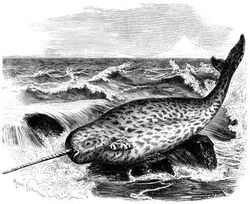
The narwhal was one of two possible explanations offered by Professor Pierre Aronnax in regards to the naval phenomena damaging ships in Jules Verne's 1870 novel Twenty Thousand Leagues Under the Sea; Aronnax comes to this conclusion by presuming that "we do know all the living species"; he was unwilling to speculate wildly to the American press. Verne writes: "The common narwhal or sea unicorn often attains a length of 18.3 m (60 ft)." For the narwhal to have caused the damage to the various vessels, Aronnax stated that its size and strength would have to increase by five or ten times;
"The narwhal is armed with a kind of ivory sword, or halberd, as some naturalists call it...Some of these tusks have been found embedded in the bodies of whales, which the narwhal always attacks with success; others have been extracted, not without difficulty, from the bottoms of ships that they had pierced right through, as a gimlet pierces a barrel...Now, suppose the weapon to be ten times stronger, and the animal ten times more powerful; launch it at a speed of 20 miles (32 km) an hour, multiply its mass by the square of its speed, and you will obtain an impact capable of producing the damage in question."[86]
Herman Melville wrote a section on the narwhal (written as "narwhale") in his 1851 novel Moby-Dick, in which he claims a narwhal tusk hung for "a long period" in Windsor Castle after Sir Martin Frobisher had given it to Queen Elizabeth. Another claim he made was that the Danish kings made their thrones from narwhal tusks.[87]
See also
- List of cetaceans
- Hai Kun-class submarine
References
- ↑ Mead, J.G.; Brownell, R. L. Jr. (2005). "Order Cetacea". in Wilson, D.E.; Reeder, D.M. Mammal Species of the World: A Taxonomic and Geographic Reference (3rd ed.). Johns Hopkins University Press. pp. 723–743. ISBN 978-0-8018-8221-0. OCLC 62265494. http://www.departments.bucknell.edu/biology/resources/msw3/browse.asp?id=14300107.
- ↑ "E. T. Newton. 1891. The vertebrata of the Pliocene deposits of Britain. Memoirs of the Geological Survey of the United Kingdom". Memoirs of the Geological Survey, Great Britain.. 1891.
- ↑ "Monodon monoceros Linnaeus 1758 (narhwal)". https://paleobiodb.org/classic/checkTaxonInfo?taxon_no=64546&is_real_user=1.
- ↑ 4.0 4.1 Lowry, L; Laidre, K; Reeves, R (2017). "Monodon monoceros". IUCN Red List of Threatened Species 2017. doi:10.2305/IUCN.UK.2017-3.RLTS.T13704A50367651.en. https://www.iucnredlist.org/species/13704/50367651.
- ↑ 5.0 5.1 "Appendices | CITES". https://cites.org/eng/app/appendices.php.
- ↑ Linnaeus, C (1758) (in la). Systema naturae per regna tria naturae, secundum classes, ordines, genera, species, cum characteribus, differentiis, synonymis, locis. Tomus I. Editio decima, reformata.. Holmiae. (Laurentii Salvii).. p. 824.
- ↑ 7.0 7.1 7.2 7.3 7.4 7.5 7.6 Heide-Jørgensen, M. P.; Laidre, K. L. (2006). Greenland's Winter Whales: The beluga, the narwhal and the bowhead whale. Ilinniusiorfik Undervisningsmiddelforlag, Nuuk, Greenland. pp. 100–125. ISBN 978-87-7975-299-3.
- ↑ 8.0 8.1 8.2 8.3 8.4 8.5 "The Narwhal: Unicorn of the Seas". Fisheries and Oceans Canada. 2007. http://www.dfo-mpo.gc.ca/science/publications/uww-msm/pdf/narwhal-narval-eng.pdf.
- ↑ Brodie, Paul (1984). Macdonald, D.. ed. The Encyclopedia of Mammals. New York: Facts on File. pp. 200–203. ISBN 978-0-87196-871-5. https://archive.org/details/encyclopediaofma00mals_0/page/200.
- ↑ Heide-Jørgensen, M. P.; Reeves, R. R. (July 1993). "Description of an Anomalous Monodontid Skull from West Greenland: A Possible Hybrid?". Marine Mammal Science 9 (3): 258–268. doi:10.1111/j.1748-7692.1993.tb00454.x. Bibcode: 1993MMamS...9..258H.
- ↑ Skovrind, Mikkel; Castruita, Jose Alfredo Samaniego; Haile, James; Treadaway, Eve C.; Gopalakrishnan, Shyam; Westbury, Michael V.; Heide-Jørgensen, Mads Peter; Szpak, Paul et al. (2019). "Hybridization between two high Arctic cetaceans confirmed by genomic analysis". Scientific Reports 9 (1): 7729. doi:10.1038/s41598-019-44038-0. PMID 31221994. Bibcode: 2019NatSR...9.7729S.
- ↑ Bianucci, Giovanni; Pesci, Fabio; Collareta, Alberto; Tinelli, Chiara (2019-05-04). "A new Monodontidae (Cetacea, Delphinoidea) from the lower Pliocene of Italy supports a warm-water origin for narwhals and white whales" (in en). Journal of Vertebrate Paleontology 39 (3): e1645148. doi:10.1080/02724634.2019.1645148. ISSN 0272-4634. Bibcode: 2019JVPal..39E5148B. https://www.tandfonline.com/doi/full/10.1080/02724634.2019.1645148. Retrieved 21 January 2024.
- ↑ Waddell, V.G.; Milinkovitch, M.C.; Bérubé, M.; Stanhope, M.J. (2000). "Molecular Phylogenetic Examination of the Delphinoidea Trichotomy: Congruent Evidence from Three Nuclear Loci Indicates That Porpoises (Phocoenidae) Share a More Recent Common Ancestry with White Whales (Monodontidae) Than They Do with True Dolphins (Delphinidae)". Molecular Phylogenetics and Evolution 15 (2): 314–318. doi:10.1006/mpev.1999.0751. PMID 10837160.
- ↑ Jorge Vélez-Juarbe; Nicholas D. Pyenson (2012). "Bohaskaia monodontoides, a new monodontid (Cetacea, Odontoceti, Delphinoidea) from the Pliocene of the western North Atlantic Ocean". Journal of Vertebrate Paleontology 32 (2): 476–484. doi:10.1080/02724634.2012.641705. Bibcode: 2012JVPal..32..476V.
- ↑ Louis, Marie; Skovrind, Mikkel; Samaniego Castruita, Jose Alfredo; Garilao, Cristina; Kaschner, Kristin; Gopalakrishnan, Shyam; Haile, James S.; Lydersen, Christian et al. (2020-04-29). "Influence of past climate change on phylogeography and demographic history of narwhals, Monodon monoceros" (in en). Proceedings of the Royal Society B: Biological Sciences 287 (1925): 20192964. doi:10.1098/rspb.2019.2964. ISSN 0962-8452. PMID 32315590.
- ↑ Racicot, Rachel A.; Darroch, Simon A. F.; Kohno, Naoki (October 2018). "Neuroanatomy and inner ear labyrinths of the narwhal, Monodon monoceros , and beluga, Delphinapterus leucas (Cetacea: Monodontidae)" (in en). Journal of Anatomy 233 (4): 421–439. doi:10.1111/joa.12862. ISSN 0021-8782. PMID 30033539.
- ↑ 17.0 17.1 17.2 17.3 17.4 17.5 17.6 17.7 17.8 17.9 Macdonald, David Whyte; Barrett, Priscilla (2001) (in en). Mammals of Europe. Princeton University Press. p. 173. ISBN 978-0-691-09160-0. https://books.google.com/books?id=GNBwQgAACAAJ. Retrieved 27 January 2024.
- ↑ "Monodon monoceros". Fisheries and Aquaculture Department: Species Fact Sheets. Food and Agriculture Organization of the United Nations. http://www.fao.org/fi/website/FIRetrieveAction.do?dom=species&fid=2742.
- ↑ Dietz, Rune; Shapiro, Ari D; Bakhtiari, Mehdi; Orr, Jack; Tyack, Peter L; Richard, Pierre; Eskesen, Ida Grønborg; Marshall, Greg (2007-11-19). "Upside-down swimming behaviour of free-ranging narwhals". BMC Ecology 7 (1): 14. doi:10.1186/1472-6785-7-14. ISSN 1472-6785. PMID 18021441. Bibcode: 2007BMCE....7...14D.
- ↑ Fontanella, Janet E.; Fish, Frank E.; Rybczynski, Natalia; Nweeia, Martin T.; Ketten, Darlene R. (2010). "Three-dimensional geometry of the narwhal (Monodon monoceros) flukes in relation to hydrodynamics". Marine Mammal Science 27 (4): 889–898. doi:10.1111/j.1748-7692.2010.00439.x.
- ↑ 21.0 21.1 21.2 21.3 21.4 Nweeia, Martin T.; Eichmiller, Frederick C.; Hauschka, Peter V.; Donahue, Gretchen A.; Orr, Jack R.; Ferguson, Steven H.; Watt, Cortney A.; Mead, James G. et al. (2014-03-18). "Sensory ability in the narwhal tooth organ system" (in en). The Anatomical Record 297 (4): 599–617. doi:10.1002/ar.22886. ISSN 1932-8486. PMID 24639076. https://anatomypubs.onlinelibrary.wiley.com/doi/10.1002/ar.22886. Retrieved 24 January 2024.
- ↑ Nweeia, Martin (20 June 2014). "Narwhal Tusk Research". Narwhal.org. http://www.narwhal.org/.
- ↑ Louis, Marie; Skovrind, Mikkel; Garde, Eva; Heide-Jørgensen, Mads Peter; Szpak, Paul; Lorenzen, Eline D. (2021-02-03). "Population-specific sex and size variation in long-term foraging ecology of belugas and narwhals" (in en). Royal Society Open Science 8 (2). doi:10.1098/rsos.202226. ISSN 2054-5703. PMID 33972883. Bibcode: 2021RSOS....802226L.
- ↑ Dietz, Rune; Desforges, Jean-Pierre; Rigét, Frank F.; Aubail, Aurore; Garde, Eva; Ambus, Per; Drimmie, Robert; Heide-Jørgensen, Mads Peter et al. (2021-05-10). "Analysis of narwhal tusks reveals lifelong feeding ecology and mercury exposure". Current Biology 31 (9): 2012–2019.e2. doi:10.1016/j.cub.2021.02.018. ISSN 0960-9822. PMID 33705717. https://www.sciencedirect.com/science/article/pii/S0960982221002256. Retrieved 26 January 2024.
- ↑ Mann, Janet (June 2000) (in en). Cetacean Societies: Field Studies of Dolphins and Whales. University of Chicago Press. pp. 247. ISBN 978-0-226-50341-7. https://books.google.com/books?id=W-UQNoxMONwC&dq=info:jxfnwaEjBm8J:scholar.google.com/&pg=PA247. Retrieved 28 January 2024.
- ↑ Dipper, Frances (2021-06-08) (in en). The Marine World: A Natural History of Ocean Life. Princeton University Press. pp. 437. ISBN 978-0-691-23244-7. https://books.google.com/books?id=lfYlEAAAQBAJ&dq=narwhal+weight&pg=PA436. Retrieved 28 January 2024.
- ↑ Lambert, K. (18 August 2008). "How Narwhals work". http://science.howstuffworks.com/zoology/marine-life/narwhal3.htm.
- ↑ Charry, Bertrand; Tissier, Emily; Iacozza, John; Marcoux, Marianne; Watt, Cortney A. (2021-08-04). "Mapping Arctic cetaceans from space: A case study for beluga and narwhal" (in en). PLOS ONE 16 (8): e0254380. doi:10.1371/journal.pone.0254380. ISSN 1932-6203. PMID 34347780. Bibcode: 2021PLoSO..1654380C.
- ↑ EALES NB (1950-10-17). "The skull of the foetal narwhal, Monodon monoceros L" (in en). Philosophical Transactions of the Royal Society of London. Series B, Biological Sciences 235 (621): 1–33. doi:10.1098/rstb.1950.0013. ISSN 2054-0280. PMID 24538734. Bibcode: 1950RSPTB.235....1E. https://royalsocietypublishing.org/doi/10.1098/rstb.1950.0013. Retrieved 26 January 2024.
- ↑ Best, Robin C. (1981-12-01). "The tusk of the narwhal ( Monodon monoceros L.): interpretation of its function (Mammalia: Cetacea)" (in en). Canadian Journal of Zoology 59 (12): 2386–2393. doi:10.1139/z81-319. ISSN 0008-4301. http://www.nrcresearchpress.com/doi/10.1139/z81-319. Retrieved 23 January 2024.
- ↑ "Sensory ability in the narwhal tooth organ system". The Anatomical Record 297 (4): 599–617. 2014. doi:10.1002/ar.22886. PMID 24639076.
- ↑ 32.0 32.1 32.2 Broad, William (13 December 2005). "It's Sensitive. Really.". The New York Times. https://www.nytimes.com/2005/12/13/science/its-sensitive-really.html?_r=0.
- ↑ Vincent, James (19 March 2014). "Scientists suggest they have the answer to the mystery of the narwhal's tusk". https://www.independent.co.uk/news/science/scientists-solve-the-mystery-of-the-narwhals-tusk-9202935.html.
- ↑ Nweeia, Martin (20 June 2014). "Narwhal Tusk Research – About the Tusk". Narwhal.org. http://www.narwhal.org/.
- ↑ 35.0 35.1 Waddell, Dave (16 May 2017). "Drone-shot video may have just solved 400-year debate over what narwhal tusks are used for" (in en). National Post. http://news.nationalpost.com/news/canada/drone-shot-video-may-have-just-solved-400-year-debate-over-what-narwhal-tusks-are-used-for.
- ↑ 36.0 36.1 Ravetch, Adam (12 May 2017). "How narwhals use their tusks" (in en). https://www.worldwildlife.org/videos/how-narwhals-use-their-tusks.
- ↑ Kelley, T.C.; Stewart, R.E.A.; Yurkowski, D.J.; Ryan, A.; Ferguson, S.H. (2014). "Mating ecology of beluga (Delphinapterus leucas) and narwhal (Monodon monoceros) as estimated by reproductive tract metrics". Marine Mammal Science 31 (2): 479–500. doi:10.1111/mms.12165.
- ↑ 38.0 38.1 "For a dentist, the narwhal's smile is a mystery of evolution". Smithsonian Insider. 18 April 2012. http://insider.si.edu/2012/04/for-dentist-the-narwhals-smile-is-a-mystery-of-evolution/.
- ↑ Westbury, Michael V.; Petersen, Bent; Garde, Eva; Heide-Jørgensen, Mads Peter; Lorenzen, Eline D. (2019-05-31). "Narwhal Genome Reveals Long-Term Low Genetic Diversity despite Current Large Abundance Size" (in English). iScience 15: 592–599. doi:10.1016/j.isci.2019.03.023. ISSN 2589-0042. PMID 31054839. Bibcode: 2019iSci...15..592W.
- ↑ 40.0 40.1 "The Biology and Ecology of Narwhals". National Oceanic and Atmospheric Administration. http://oceanexplorer.noaa.gov/explorations/06arctic/background/biology/biology.html.
- ↑ 41.0 41.1 Laidre, K. L.; Heide-Jørgensen, M. P.; Dietz, R.; Hobbs, R. C.; Jørgensen, O. A. (2003). "Deep-diving by narwhals, Monodon monoceros: differences in foraging behavior between wintering areas?". Marine Ecology Progress Series 261: 269–281. doi:10.3354/meps261269. Bibcode: 2003MEPS..261..269L. http://orbit.dtu.dk/files/3694043/Jorgensen.pdf. Retrieved 20 April 2018.
- ↑ Chambault, P.; Tervo, O. M.; Garde, E.; Hansen, R. G.; Blackwell, S. B.; Williams, T. M.; Dietz, R.; Albertsen, C. M. et al. (2020-10-29). "The impact of rising sea temperatures on an Arctic top predator, the narwhal" (in en). Scientific Reports 10 (1): 18678. doi:10.1038/s41598-020-75658-6. ISSN 2045-2322. PMID 33122802. Bibcode: 2020NatSR..1018678C.
- ↑ 43.0 43.1 43.2 Laidre, K (2004). "Deep-ocean predation by a high Arctic cetacean". ICES Journal of Marine Science 61 (1): 430–440. doi:10.1016/j.icesjms.2004.02.002. Bibcode: 2004ICJMS..61..430L.
- ↑ 44.0 44.1 44.2 Laidre, K.L.; Heide-Jørgensen, M. P. (2005). "Winter feeding intensity of narwhals". Marine Mammal Science 21 (1): 45–57. doi:10.1111/j.1748-7692.2005.tb01207.x.
- ↑ Finley, K. J.; Gibb, E. J. (1 December 1982). "Summer diet of the narwhal (Monodon monoceros) in Pond Inlet, northern Baffin Island". Canadian Journal of Zoology 60 (12): 3353–3363. doi:10.1139/z82-424. ISSN 0008-4301.
- ↑ Jensen, Frederik H.; Tervo, Outi M.; Heide-Jørgensen, Mads Peter; Ditlevsen, Susanne (2023-03-25). "Detecting narwhal foraging behaviour from accelerometer and depth data using mixed-effects logistic regression". Animal Biotelemetry 11 (1): 14. doi:10.1186/s40317-023-00325-2. ISSN 2050-3385. Bibcode: 2023AnBio..11...14J.
- ↑ Finley, K.J.; Gidd, E.J. (1982). "Summer diet of the narwhal (Monodon monoceros) in Pond Inlet, northern Baffin Island". Canadian Journal of Zoology 60 (12): 3353–3363. doi:10.1139/z82-424.
- ↑ Resources, International Union for Conservation of Nature and Natural (1991) (in en). Dolphins, Porpoises and Whales of the World: The IUCN Red Data Book. IUCN. pp. 79. ISBN 978-2-88032-936-5. https://books.google.com/books?id=QynOriR1MxEC&dq=Narwhal+reproduction&pg=PA85. Retrieved 28 January 2024.
- ↑ Tinker, Spencer Wilkie (1988-01-01) (in en). Whales of the World. Brill Archive. pp. 213. ISBN 978-0-935848-47-2. https://books.google.com/books?id=ASIVAAAAIAAJ&dq=Narwhal+reproduction&pg=PA213. Retrieved 28 January 2024.
- ↑ 50.0 50.1 Garde, Eva; Hansen, Steen H.; Ditlevsen, Susanne; Tvermosegaard, Ketil Biering; Hansen, Johan; Harding, Karin C.; Heide-Jørgensen, Mads Peter (2015-07-07). "Life history parameters of narwhals (Monodon monoceros) from Greenland". Journal of Mammalogy 96 (4): 866–879. doi:10.1093/jmammal/gyv110. ISSN 0022-2372. http://dx.doi.org/10.1093/jmammal/gyv110. Retrieved 22 January 2024.
- ↑ 51.0 51.1 Evans Ogden, Lesley (6 January 2016). "Elusive narwhal babies spotted gathering at Canadian nursery". New Scientist. https://www.newscientist.com/article/dn28729-elusive-narwhal-babies-spotted-gathering-at-canadian-nursery/. Retrieved 6 September 2016.
- ↑ "First-Ever Beluga-Narwhal Hybrid Found in the Arctic". 20 June 2019. https://www.livescience.com/65757-first-beluga-narwhal-hybrid.html.
- ↑ Skovrind, M.l; Castruita, J. A. S.; Haile, J. et al. (2019). "Hybridization between two high Arctic cetaceans confirmed by genomic analysis". Scientific Reports 9 (1): 7729. doi:10.1038/s41598-019-44038-0. PMID 31221994. Bibcode: 2019NatSR...9.7729S.
- ↑ 54.0 54.1 54.2 54.3 Marcoux, M. (2011). "Chapter 1". Narwhal communication and grouping behaviour: a case study in social cetacean research and monitoring (PDF) (PhD). Montreal: McGill University. pp. 6–9. Archived (PDF) from the original on 28 January 2024. Retrieved 27 January 2024.
- ↑ Still, Robert; Harrop, Hugh; Dias, Luís; Stenton, Tim (2019-07-16) (in en). Europe's Sea Mammals Including the Azores, Madeira, the Canary Islands and Cape Verde: A field guide to the whales, dolphins, porpoises and seals. Princeton University Press. pp. 16. ISBN 978-0-691-19062-4. https://books.google.com/books?id=z9B-DwAAQBAJ&dq=Narwhal+reproduction&pg=PA161. Retrieved 28 January 2024.
- ↑ Miller, Lee A.; Pristed, John; Møshl, Bertel; Surlykke, Annemarie (October 1995). "THE CLICK-SOUNDS OF NARWHALS ( MONODON MONOCEROS ) IN INGLEFIELD BAY, NORTHWEST GREENLAND" (in en). Marine Mammal Science 11 (4): 491–502. doi:10.1111/j.1748-7692.1995.tb00672.x. ISSN 0824-0469. Bibcode: 1995MMamS..11..491M. https://onlinelibrary.wiley.com/doi/10.1111/j.1748-7692.1995.tb00672.x. Retrieved 27 January 2024.
- ↑ Lesage, V.; Barrette, C.; Kingsley, M.C.S; Sjare, B. (1999). "The effect of vessel noise on the vocal behavior of belugas in the St. Lawrence River estuary, Canada.". Marine Mammal Science 15 (1): 65–84. doi:10.1111/j.1748-7692.1999.tb00782.x. Bibcode: 1999MMamS..15...65L.
- ↑ Garde, E.; Heide-Jørgensen, M.P.; Hansen, S.H.; Nachman, G.; Forchhammer, M.C. (2007). "Age-Specific Growth and Remarkable Longevity in Narwhals (Monodon monoceros) from West Greenland as Estimated by Aspartic Acid Racemization". Journal of Mammalogy 88 (1): 49–58. doi:10.1644/06-MAMM-A-056R.1.
- ↑ 59.0 59.1 Laidre K.; Heide-Jorgensen, M.P.; Stern, H.; Richard, P. (2011). "Unusual narwhal sea ice entrapments and delayed autumn freeze-up trends". Polar Biology 35: 149–154. doi:10.1007/s00300-011-1036-8. http://staff.washington.edu/klaidre/docs/Laidreetal_2012.pdf. Retrieved 17 June 2013.
- ↑ 60.0 60.1 Williams, Terrie M.; Noren, Shawn R.; Glenn, Mike (2011). "Extreme physiological adaptations as predictors of climate-change sensitivity in the narwhal, Mondon monceros". Marine Mammal Science 27 (2): 334. doi:10.1111/j.1748-7692.2010.00408.x.
- ↑ Porsild, M. (1918). "On 'Savssat': A crowding of Arctic animals at holes in the sea ice". Geogr Rev 6 (3): 215–228. doi:10.2307/207815.
- ↑ William F. Perrin, ed (2009). Encyclopedia of Marine Mammals. Academic Press. pp. 929–30. ISBN 978-0080919935. https://books.google.com/books?id=2rkHQpToi9sC&q=narwhals+attacked+by+polar+bears&pg=PA929. Retrieved 18 November 2020.
- ↑ Ferguson, S. H.; Higdon, J. W.; Westdal, K. H. (2012). "Prey items and predation behavior of killer whales (Orcinus orca) in Nunavut, Canada based on Inuit hunter interviews". Aquatic Biosystems 8 (3): 3. doi:10.1186/2046-9063-8-3. PMID 22520955. Bibcode: 2012AqBio...8....3F.
- ↑ "Invasion of the Killer Whales: Killer Whales Attack Pod of Narwhal". Public Broadcasting System. 19 November 2014. https://www.pbs.org/wnet/nature/invasion-killer-whales-killer-whales-attack-pod-narwhals/11165/.
- ↑ Wittig, Lars (18 June 2016). "Meta population modelling of narwhals in East Canada and West Greenland – 2017". bioRxiv 10.1101/059691.
- ↑ 66.0 66.1 66.2 66.3 66.4 "Estimating the Economic Value of Narwhal and Beluga Hunts in Hudson Bay, Nunavut". The Arctic Institute of North America 66: 1–16. March 2013. https://arctic.journalhosting.ucalgary.ca/arctic/index.php/arctic/article/view/4261/4242. Retrieved 9 July 2018.
- ↑ Greenfieldboyce, Nell (19 August 2009). "Inuit Hunters Help Scientists Track Narwhals". NPR.org (National Public Radio). https://www.npr.org/2009/08/19/111980557/inuit-hunters-help-scientists-track-narwhals.
- ↑ 68.0 68.1 Heide-Jørgensen, Mads Peter (January 1994). "Distribution, exploitation and population status of white whales (Delphinapterus leucas) and narwhals (Monodon monoceros) in West Greenland" (in en). Meddelelser om Grønland, Bioscience 39: 135–149. doi:10.7146/mogbiosci.v39.142541. https://www.researchgate.net/publication/285286297.
- ↑ Heide-Jørgensen, M. P. (2018-01-01), Würsig, Bernd; Thewissen, J. G. M.; Kovacs, Kit M., eds., Narwhal: Monodon monoceros, Academic Press, pp. 627–631, ISBN 978-0-12-804327-1, https://www.sciencedirect.com/science/article/pii/B9780128043271000133, retrieved 2024-01-27
- ↑ Belikov, Stanislav E.; Boltunov, Andrei N. (2002-07-21). "Distribution and migrations of cetaceans in the Russian Arctic according to observations from aerial ice reconnaissance" (in en). NAMMCO Scientific Publications 4: 69–86. doi:10.7557/3.2838. ISSN 2309-2491. https://septentrio.uit.no/index.php/NAMMCOSP/article/view/2838. Retrieved 27 January 2024.
- ↑ 71.0 71.1 Watt, C.A.; Orr, J.R.; Ferguson, S.H. (January 2017). "Spatial distribution of narwhal ( Monodon monoceros ) diving for Canadian populations helps identify important seasonal foraging areas" (in en). Canadian Journal of Zoology 95 (1): 41–50. doi:10.1139/cjz-2016-0178. ISSN 0008-4301. http://www.nrcresearchpress.com/doi/10.1139/cjz-2016-0178. Retrieved 20 January 2024.
- ↑ 72.0 72.1 Laidre, K. L.; Stirling, I.; Lowry, L.; Wiig, Ø.; Heide-Jørgensen, M. P.; Ferguson, S. (2008). "Quantifying the sensitivity of arctic marine mammals to climate-induced habitat change". Ecological Applications 18 (2): S97–S125. doi:10.1890/06-0546.1. PMID 18494365. Bibcode: 2008EcoAp..18S..97L.
- ↑ "Fact sheet narwhal and climate change| CITES". https://www.cms.int/sites/default/files/publication/fact_sheet_narwhal_climate_change.pdf.
- ↑ Lowry, L.; Laidre, K.; Reeves, R. (2017). "Monodon monoceros". IUCN Red List of Threatened Species 2017: e.T13704A50367651. doi:10.2305/IUCN.UK.2017-3.RLTS.T13704A50367651.en. https://www.iucnredlist.org/species/13704/50367651. Retrieved 12 November 2021.
- ↑ Wagemann, R.; Snow, N. B.; Lutz, A.; Scott, D. P. (1983). "Heavy Metals in Tissues and Organs of the Narwhal (Monodon monoceras)". Canadian Journal of Fisheries and Aquatic Sciences 40 (S2): s206–s214. doi:10.1139/f83-326.
- ↑ 76.0 76.1 Laidre, KL; Heide-Jørgensen, MP (2011). "Life in the lead: extreme densities of narwhals Monodon monoceros in the offshore pack ice". Marine Ecology Progress Series 423: 269–278. doi:10.3354/meps08941. Bibcode: 2011MEPS..423..269L.
- ↑ Laidre, Kristin L.; Heide-Jørgensen, Mads Peter (2005-02-01). "Arctic sea ice trends and narwhal vulnerability". Biological Conservation 121 (4): 509–517. doi:10.1016/j.biocon.2004.06.003. ISSN 0006-3207. Bibcode: 2005BCons.121..509L. https://www.sciencedirect.com/science/article/pii/S0006320704002381.
- ↑ Nielsen M.R. (2009). "Is climate change causing the increasing narwhal (Monodon monoceros) catches in Smith Sound, Greenland?". Polar Research 28 (2): 238–245. doi:10.1111/j.1751-8369.2009.00106.x. Bibcode: 2009PolRe..28..238N.
- ↑ Heide-Jørgensen, M. P.; Hansen, R. G.; Westdal, K.; Reeves, R. R.; Mosbech, A. (2013). "Narwhals and seismic exploration: Is seismic noise increasing the risk of ice entrapments?". Biological Conservation 158: 50–54. doi:10.1016/j.biocon.2012.08.005. Bibcode: 2013BCons.158...50H.
- ↑ Bastian, Dawn E.; Mitchell, Judy K. (2004). Handbook of Native American Mythology. ABC-CLIO. pp. 54–55. ISBN 978-1-85109-533-9. https://books.google.com/books?id=IsyQu1kDK-kC.
- ↑ 81.0 81.1 81.2 Shepard, Odell (2013). The Lore of the Unicorn. CreateSpace Independent Publishing Platform. p. 176. ISBN 978-1-4565-6952-5.
- ↑ Daston, Lorraine and Park, Katharine (2001). Wonders and the Order of Nature, 1150–1750. New York: Zone Books, ISBN:0-942299-91-4.
- ↑ "Narwhal Tusk, Warwick Castle". https://www.fotolibra.com/gallery/1273341/narwhal-tusk-warwick-castle/.
- ↑ Sherman, Josepha (2015). Storytelling: An Encyclopedia of Mythology and Folklore. Routledge. p. 476. ISBN 9781317459385. https://books.google.com/books?id=n2-sBwAAQBAJ&pg=PA476. Retrieved 18 September 2023.
- ↑ Officer, L. H.; Williamson, S. H. (2014). "Purchasing Power of British Pounds from 1270 to Present". MeasuringWorth. http://www.measuringworth.com/ppoweruk/.
- ↑ Verne, J. (1870). Twenty Thousand Leagues Under the Sea. Pierre-Jules Hetzel. p. 10. http://www2.hn.psu.edu/faculty/jmanis/julesverne/20000leagues.pdf. Retrieved 22 March 2014.
- ↑ Melville, H. (1851). Moby-Dick; Or The Whale. Richard Bentley. p. 635. http://www.gutenberg.org/files/2701/2701-h/2701-h.htm. Retrieved 22 March 2014.
Further reading
- Ford, John; Ford, Deborah (March 1986). "Narwhal: Unicorn of the Arctic Seas". National Geographic 169 (3): 354–363. ISSN 0027-9358. OCLC 643483454.
- M. P. Heide-Jorgensen. "Narwhal", in Encyclopedia of Marine Mammals , Perrin, Wursig and Thewissen eds. ISBN:0-12-551340-2
- Groc, Isabelle. "Hunt for the sea unicorn", New Scientist feature article, Issue 2956, 15 February 2014 [1]
External links
 |

